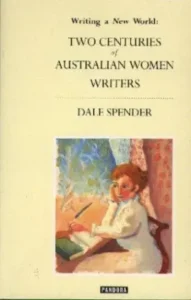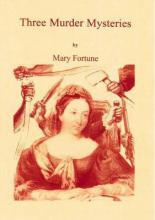by Stacey Roberts
 We didn’t set out to do a series on women in domestic service, but Stacey’s essays (here and on May 10) have inspired us to pull together her work with a couple of earlier reviews and two new ones, and have ended up with a fascinating overview both of early Australian women’s fiction, and of life ‘beneath the stairs’ – or out the back, more often.
We didn’t set out to do a series on women in domestic service, but Stacey’s essays (here and on May 10) have inspired us to pull together her work with a couple of earlier reviews and two new ones, and have ended up with a fascinating overview both of early Australian women’s fiction, and of life ‘beneath the stairs’ – or out the back, more often.
Indigenous women:
Aboriginal domestic servants in colonial women’s fiction, 1854-1906
Alice Nannup, When the Pelican Laughed (review, next month).
Convicts:
Caroline Leakey, The Broad Arrow (review)
Free (white) Servants:
Catherine Helen Spence, Clara Morison (review)
Louisa Atkinson, Gertrude the Emigrant (review)
Stacey Roberts, The later colonial servant as deliberately unsettling (essay, below)
Oh! The servant girl, the servant girl, she is the bane of life,
She fries the steaks, and steals your clothes, and fills your soul with strife.
She throws the silver in the swill, and when the room she dusts,
She drives holes in the Meissonniers and dislocates the busts.
And when you for the parlor go a-flying through the hall,
You are in time to see her knock the nozzle off St. Paul.
The servant girl, the servant girl, I think she ought to be,
With twenty grindstones round her neck, ten leagues beneath the sea.
“The Servant Girl”, Evening News (Sydney), 24 Feb., 1886.
The female domestic servant in colonial Australia was a contentious creature. Employed to tend the settler home, she was often criticised for her capacity to unsettle instead — initially due to a lack of training in the specific needs of the colonial household, and in later years, through increased personal agency and labour choices for women.
The success of the imperial project of colonisation in the land now called Australia relied heavily on orderly homes helmed by moral women assisted by loyal servants. Without a definable servant class in the colonies, however, and with the abolition of assigned convict labour, employers were required to make do with a less-reliable mix of skills, loyalty and abilities in the available labour pool. This ranged from young emigrant women (usually Irish, often impoverished, and occasionally orphaned) to the uneducated and untrained daughters of stationhands and neighbours, local Aboriginal girls, or young women who intended to work only a short while until marriage or other employment prospects beckoned.
As Susan Martin has argued, colonial women’s writing has been “violently rejected and ridiculed as trivial, conservative, Imperial, anti-nationalistic and un-Australian” because it has been focused on the domestic. This feminine, “sentimental” perspective was seen as less likely to assume or address “common national values”, the supposed ideal for Australian literature. Female authors were overlooked in favour of male writers for inclusion in the Australian canon, which had been curated and implemented primarily by postwar arbiters around texts that instead “exhibited features consistent with the perceived values of the 1890s”, chiefly “unique Australianness”, mateship, and masculinity
 Debra Adelaide, A Bright and Fiery Troop: Australian Women Writers of the Nineteenth Century (1988), and Australian Women Writers: A Bibliographic Guide (1988), and Dale Spender, Writing a New World – Two Centuries of Australian Women Writers (1988), have both contributed meticulous research focused on restoring women writers to the Australian canon. Tamara Wagner also has produced compelling research on the “neglected genre” of nineteenth-century domestic settler writing in Australia and New Zealand
Debra Adelaide, A Bright and Fiery Troop: Australian Women Writers of the Nineteenth Century (1988), and Australian Women Writers: A Bibliographic Guide (1988), and Dale Spender, Writing a New World – Two Centuries of Australian Women Writers (1988), have both contributed meticulous research focused on restoring women writers to the Australian canon. Tamara Wagner also has produced compelling research on the “neglected genre” of nineteenth-century domestic settler writing in Australia and New Zealand
In the latter half of the nineteenth century the demand for domestic servants increased as the population grew. The perpetual search for the ideal servant “bred for the task” in the English manner was usually met with defeat, employers instead having to manage with the varying capabilities, suitability, loyalty and temperament of colonial women.
Ellen “Ellie” Liston (1838-1885), an English emigrant author and postal worker who had worked in colonial service herself as a governess, caricatures both desperate mistress and insouciant servant in the “Ladies Column” of the Adelaide Evening Journal in 1882 with “Our Domestic Helps”. Housewife Kit complains her household has been “taken possession of … and as quickly deserted” by a chorus of young, conceited, and incompetent women. When Kit does manage to find a servant willing to stay, one is found too drunk and dishevelled to prepare breakfast, another is a “perfect terror of untidy, slovenly filthiness”, and the last is “a piece of middle-aged volubility and temper” who is summarily dismissed after an embarrassing screaming tantrum.
Mabel Forrest (1872-1935) grew up on a remote pastoral station in Queensland and once married, wrote to supplement the family income. A prolific author, Forrest’s themes ranged from Australian bush life to fidelity and betrayal in love, with her first unsuccessful marriage forming the basis of much of her work.
“Frances Floriline” was a short story published in The Queenslander (1896) in which Forrest explores the comical tension between an enthusiastic novice bush housekeeper and the only servant she can find in such a remote place: a local boundary-rider’s daughter with absolutely no domestic training. Frances, who “all her life had only had the wide plains or sparsely-scattered gum-trees for companionship”, is illiterate and uncouth, with a “stupid little face” and a frightful habit of relentlessly mocking her mistress who is desperate to succeed at “housekeeping in the bush”. She sets the table “pell-mell”, can’t make bread, can’t turn out a pudding, regularly burns the beef, and is suspected of often sneaking male company into the kitchen. Required to help her mistress host her first dinner party as a nervous new bride, Frances’ reign of incompetence culminates in an embarrassing cacophony of failure.
To add insult to injury, once the “miserable meal” has been got through with difficulty, the incensed housewife goes in search of Frances only to find her, completely unrepentant, on the knee of Bill the head-stockman in the “moonlit vegetable garden”, her head “sentimentally against his shoulder”. Frances is never seen again.
The capacity of the colonial female servant for seduction — and thus the possibility of destabilising established relationships in the home — is a common thread that unites author, era and genre.
Another Forrest character, Frank Fort in “The Housekeeper” (1906) is determined to employ only a middle-aged housekeeper, one with no romantic potential whatever, so as not to “scandalise the community” and also safeguard his own heart. His friend and neighbour, Percival O’Dowd, insists he employ “something over 50, and be on the safe side”.
Mrs Armitage is a success at the station from the start, but this only serves to make O’Dowd suspicious — particularly because she is far more attractive than either man had expected. In the end, Frank Fort follows convention and marries his neighbour’s daughter. Such an abrupt change of heart after a promising romantic beginning drives the heartbroken housekeeper from the home. O’Dowd intercepts Mrs Armitage on the road out of town and begs for her hand in marriage, but is rejected.
Thus the household is ruptured and three characters left heavy-hearted, with O’Dowd riding away alone, “as he was to ride all his days”, Fort tearing out of the garden the yellow roses that remind him of his lost love, and Mrs Armitage “on the wallaby again” roaming the countryside for work. Regardless of her intention, Mrs Armitage’s seductive capacity in her role as unmarried housekeeper causes irreversible damage to a friendship and turns a once-happy home into an empty one of regret.
This stereotype of the housekeeper with the potential to seduce her master also features in Mary Fortune’s “The Hart Murder” (1870), where protagonist detective Mark Sinclair warns his friend Squire Crawford that the woman he recently employed for Illancarra Station, sight unseen, might unexpectedly turn out to be “some very nice amiable widow coming the soft sawder over your heart, and then what will Miss Mary say to a new mamma?”.
 Mary Fortune (1833-1911) writing under the pseudonym W. W., or Waif Wander, was a prolific author, considered one of the world’s earliest women detective writers — certainly the first in Australia.
Mary Fortune (1833-1911) writing under the pseudonym W. W., or Waif Wander, was a prolific author, considered one of the world’s earliest women detective writers — certainly the first in Australia.
Fortune took advantage of the servant figure’s imagined capability to unsettle the home to provide motivation for the villains in two of her many short stories. Mrs Inchkeith, of “Mrs Inchkeith’s Revenge”, is a jilted lover who has schemed her way into the household of her one-time paramour, Mr Burgess, resulting in a spectacularly tragic rupture of the family unit. Hired as housekeeper after the suicide of Mrs Burgess, she positions herself as surrogate wife to the grieving husband, wearing expensive silk dresses and dining with him as his equal. Her machinations to supplant his dead wife and reclaim her rightful place beside Mr Burgess come unstuck when Ellen Jay, the Irish under-nurse, recognises Inchkeith from a previous household, and blackmails her with evidence that she orchestrated Mrs Burgess’s death.
Mary Fortune’s second criminal housekeeper, in “The Hart Murder”, is a potentially seductive threat to Squire Crawford of Illancarra Station in rural Victoria. The middle-aged Mrs Bell is sent from a Melbourne agency, arriving at the same time as Detective Mark Sinclair, who is there to recuperate after a horse-riding accident. Sinclair had been in the area on the trail of a young Miss Fairweather, accused of the violent death of her elderly employer Mrs Hart in a will dispute. After a series of events that cause Sinclair to suspect the newly-hired Mrs Bell of harbouring information regarding the whereabouts of Miss Fairweather, it is revealed that the housekeeper is in fact the girl in question, disguised as an older woman and attempting to live quietly on a remote station until the furore around the crime subsides.
It was a common complaint in the colonies at the end of the nineteenth century that haughty, incompetent domestic servants reigned in “tyrannical domination over a cowering country”. Women’s ability to choose better pay and conditions for themselves or to opt out of domestic service entirely in favour of work in factories and shops infuriated the upper classes, who found themselves without a solid workforce trained for subservient household management.
With articles regarding the “servant question” rife throughout the popular press, and complaints of “useless and unornamental” servant girls subjecting “unfortunate employers” to ceaseless “extortion and incompetence” a daily feature, the servant girl in literary fiction was ripe for darker and more complex narrative possibilities. Each of the servants — Liston’s litany of unnamed girls, the hapless Frances Floriline, and the murderous Mrs Inchkeith and Miss Fairweather — unsettle.
The domestic servant as a deliberately destabilising force in fiction came to prominence in the later years of the 1800s. With their capacity for wider narrative possibilities than they were afforded in the romance genre popular in earlier years, these women drank, schemed, demanded, seduced and even murdered their way through colonial homes.
Colonial female writers employed the servant girl figure in their works for their ability to destabilise the colonial home, the settlement of which was so vital for imperial success. While each was portrayed with varying levels of sympathy for their varying reasons for undermining domestic wellbeing — from innocence and circumstance to malice and premeditation — they all in their own ways still unsettled the colonial settlement
.
Stacey Roberts graduated with a Bachelor of Journalism, and was a freelance writer and blogger for a decade before completing a Graduate Diploma in English and Theatre Studies. She is now undertaking a PhD. Stacey blogs at allforbiblichor.wordpress.com.
.
Bibliography
Adelaide, Debra, editor. A Bright and Fiery Troop: Australian Women Writers of the Nineteenth Century. Penguin, Ringwood, Victoria, 1988.
Amies, Marion. “The Victorian Governess and Colonial Ideals of Womanhood”. Victorian Studies, vol. 31, no. 4, 1988, pp. 537–65. JSTOR, http://www.jstor.org/stable/3827856.
Bennett, Bruce, and Strauss, Jennifer, editors. The Oxford Literary History of Australia. Oxford University Press, Melbourne, 1998.
Coleman, Deirdre, editor. Women Writing Home, 1700-1920: Female Correspondence across the British Empire. Vol. 2 Australia. Pickering & Chatto, London, 2006.
Ferres, Kay. “Mabel Forrest (1872-1935).” Australian Dictionary of Biography, 2006.
https://adb.anu.edu.au/biography/forrest-mabel-12922.
Fortune, Mary. “Mrs Inchkeith’s Revenge.” The Australian Journal, vol. 15 no. 175, December 1879, pp. 176-83.
—. “The Hart Murder.” Three Murder Mysteries. Canberra, Mulini Press, 2009.
Forrest, Mabel. “Frances Floriline”. The Queenslander, 12 Dec. 1896. https://trove.nla.gov.au/newspaper/article/20767549.
—. “The Housekeeper.” 1906. The Anthology of Colonial Australian Romance Fiction. Melbourne University Press, 2010.
Gelder, Ken, and Weaver, Rachael, editors. The Anthology of Colonial Romance Fiction. Melbourne University Press, 2010.
Feminist Studies, vol. 16, no. 34, Mar. 2001, pp. 13–25. Taylor & Francis Online, DOI: 10.1080/08164640120038881.
Higman, B. W. Domestic Service In Australia. Melbourne University Press, 2002.
“Irish Orphan Girls.” Freemans Journal, 11 Jul. 1850, p. 5,
https://trove.nla.gov.au/newspaper/article/115765917.
Liston, Ellie. “Ladies Column: Our Domestic Helps.” Adelaide Observer, 2 Sep. 1882, p. 42, https://trove.nla.gov.au/newspaper/article/160161239.
McKernan, Susan. “Two Early Novelists: Anna Maria Bunn and Mary Theresa Vidal.” A Bright and Fiery Troop: Australian Women Writers of the Nineteenth Century, edited by Debra Adelaide. Penguin, Ringwood, Victoria, 1988.
Moodie, Georgia. “Braithwaite, Maria (1861-1927).” The Australian Women’s Register, 2009, https://www.womenaustralia.info/biogs/AWE4000b.htm.
Moore, Grace, and Smith, Michelle J., editors. Victorian Environments: Acclimatising to Change in British Domestic and Colonial Culture. Palgrave Macmillan, London, 2018.
O’Brien, Charmaine. The colonial kitchen: Australia, 1788-1901. Rowman & Littlefield Lanham, Maryland, 2016.
Peabody, Hiram W. “The Peabody Correspondence. Letter the Eighth”. Letter. The People’s Advocate and New South Wales Vindicator, 14 Dec. 1850, p. 7,
https://trove.nla.gov.au/newspaper/article/251539669.
Reid, Kirsty. Gender, crime and empire: convicts, settlers and the state in early colonial Australia. University Press Manchester, 2007.
Rushen, Elizabeth A. Single & free: female migration to Australia, 1833 – 1837. Anchor Books Australia, Collins Street East, 2011.
Steiner, Marie A. Servants Depots in Colonial South Australia. Wakefield Press, 2009.
Sussex, Lucy. “Shrouded in Mystery: Waif Wander (Mary Fortune)”, A Bright and Fiery Troop: Australian Women Writers of the Nineteenth Century, edited by Debra Adelaide. Penguin, Ringwood, Victoria, 1988.
Swain, Shurlee. “Maids and Mothers: Domestic Servants and Illegitimacy in 19th-Century Australia.” History of the Family, vol. 10, no. 4, Dec. 2005, pp. 461–71. EBSCOhost, https://www.tandfonline.com/doi/abs/10.1016/j.hisfam.2005.09.007.
“The Distressed Needle-Women.” South Australian Gazette and Mining Journal, 10th August, 1850, p3, https://trove.nla.gov.au/newspaper/article/195940539.
“The Servant Girl.” The Richmond River Herald and Northern Districts Advertiser (NSW 1886-1942), 7 Dec. 1888, page 4, https://trove.nla.gov.au/newspaper/article/127717824.
“The Servant Girl Question.” The Cairns Post, 11 May, 1887, https://trove.nla.gov.au/newspaper/article/39421589.
“No Title”. The Prahran Telegraph, 2 Nov. 1889, https://trove.nla.gov.au/newspaper/article/117003850/10132876.
Wagner, Tamara S., editor. Domestic fiction in colonial Australia and New Zealand. Pickering & Chatto, London, 2014.





All of my ancestors came out to Australia from the British Isles in the 1850s, mostly middle class English who became farmers or ran small businesses on the various goldfields; but one was a poor, illiterate Irish girl who came out to be a servant and who ended up the wife of one of Queensland’s most prosperous merchants.
The most unsettling servant in early lit. that I can think of is the housekeeper in Rosa Praed’s Lady Bridget in the Never Never Land, who rules the outback property where Bridget is taken as a young bride and had previously been her husband’s mistress.
Fascinating glimpse into your family history, Bill. Do you think that overwhelmingly middle-class heritage filtered through to the present generation, valuing education and reading, for example? Did the Irish girl also value these things, once she achieved a position of prosperity?
I can’t answer you directly Elizabeth, it was too long ago, though years ago I wrote all I knew on this subject about my and Milly’s families in a post ‘Educating Women’. I can say mum’s parents, farmers who left school at 14, valued reading as much as dad’s, who were private school and tertiary educated.
You were lucky to have such ancestors, Bill, and their love of reading handed down to you.
Thanks for these insights, Stacey.
Thank you again for having me!